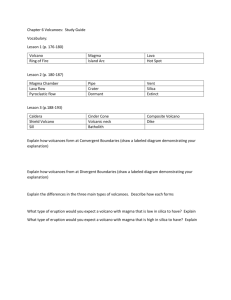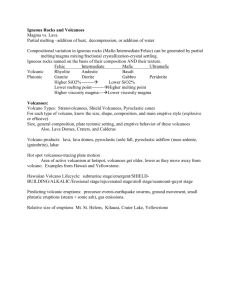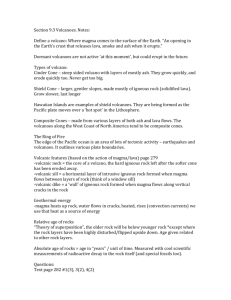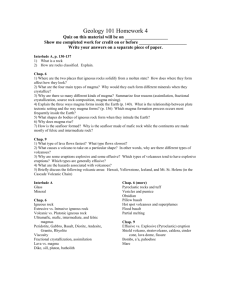Volcanoes!
advertisement
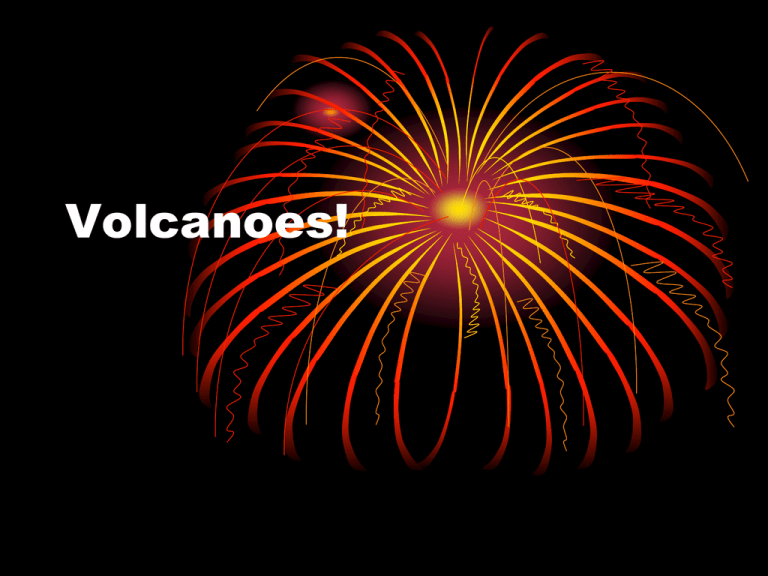
Volcanoes! Volcanism - the formation of volcanoes A. Molten rock 1. magma – molten rock below the Earth’s surface 2. Where rock will melt - rock melts in the asthenosphere - rock also melts at the plate boundaries due to friction created during plate movements B. Movement of magma 1. magma is less dense than solid rock therefore it will rise 2. magma will push thru cracks in crust pushed upwards 3. when it reaches the surface – a volcano forms Volcanoes - magma affects volcano shape Shield cone volcano ▲ Low, wide based volcanoes ▲ Example : Hawaiian volcanoes ▲ Mafic magma • thinner in viscosity, flows easily • oozes out, forming a shield shape as each layer flows and hardens • fewer gases in this form • eruptions not very explosive ▲ Mafic lava erupts and then flows easily ▲ Produces pahoehoe features (ropey, mafic lava) Volcanoes – how magma affects volcano shape Cinder cone volcano ▲ Tall, steep, narrow based volcanoes ▲ Example : Mt. St. Helens ▲ Felsic magma • thicker viscosity, slower moving • eruptions are often violent • lava is blocky (aa) features, felsic in nature ▲ Large amounts of gas trapped in magma • • • • carbon dioxide, carbon monoxide, sulfur oxide All dangerous, poisonous in some cases Even superheated steam can be formed Sudden expansion of these gases similar to a soda bottle being shaken!!! Volcanoes – how magma affects volcano shape When volcanoes erupt violently ▲Lava fragments called tephra thrown out • ash - less than 2 mm in size - smallest kind • lapilli - 2 mm to 64 mm in size • over 64 mm in size – two kinds blocks – launched and land as solid chunks bombs – launched as liquid, solidifies as it falls ▲Pyroclastic cloud • tephra mixed in with volcanic, superheated gases • can move at very high speeds (200 mph!) Why Volcanoes are Hazardous! Volcanoes – how magma affects volcano shape ▲Examples ▲Mt. Vesuvius and the end of Pompeii ▲Krakatoa, Indonesia ▲Mt. St. Helens, Washington State ▲Mt. Pinatuba, Philipines Cities in Dust" by Siouxsie and the Banshees • Water was running; children were running You were running out of time Under the mountain, a golden fountain Were you praying at the Lares shrine? • We found you hiding, we found you lying Choking on the dirt and sand Your former glories and all the stories Dragged and washed with eager hands Cities in Dust" by Siouxsie and the Banshees • Water was running; children were running We found you hiding, we found you lying Water was running; children were running We found you hiding, we found you lying your city lies in dust • Hot and burning in your nostrils Pouring down your gaping mouth Your molten bodies blanket of cinders Caught in the throes ....... • But ohh oh your city lies in dust, my friend ohh oh your city lies in dust, my friend your city lies in dust Plutonic Activity – when magma doesn’t reach the surface Trivia - Who was Pluto? What was his name in Greek mythology? • Plutons – igneous intrusions below the surface • Sills – igneous intrusion that are parallel to existing rock layers • Dikes – igneous intrusions that cut across rock layers • Laccolith – igneous intrusion that pushes up existing layers to form a dome shape • Neck – remains of the center of an extinct volcano after outside edges are eroded • Batholiths – massive underground intrusions • Stocks – less massive underground intrusions (under a hundred square miles) Plutonic Activity – when magma doesn’t reach the surface Trivia - Who was Pluto? What was his name in Greek mythology? • Plutons – igneous intrusions below the surface • Sills – igneous intrusion that are parallel to existing rock layers • Dikes – igneous intrusions that cut across rock layers • Laccolith – igneous intrusion that pushes up existing layers to form a dome shape • Neck – remains of the center of an extinct volcano after outside edges are eroded • Batholiths – massive underground intrusions • Stocks – less massive underground intrusions (under a hundred square miles) Plutonic Activity – when magma doesn’t reach the surface Trivia - Who was Pluto? What was his name in Greek mythology? • Plutons – igneous intrusions below the surface • Sills – igneous intrusion that are parallel to existing rock layers • Dikes – igneous intrusions that cut across rock layers • Laccolith – igneous intrusion that pushes up existing layers to form a dome shape • Neck – remains of the center of an extinct volcano after outside edges are eroded • Batholiths – massive underground intrusions • Stocks – less massive underground intrusions (under a hundred square miles)

